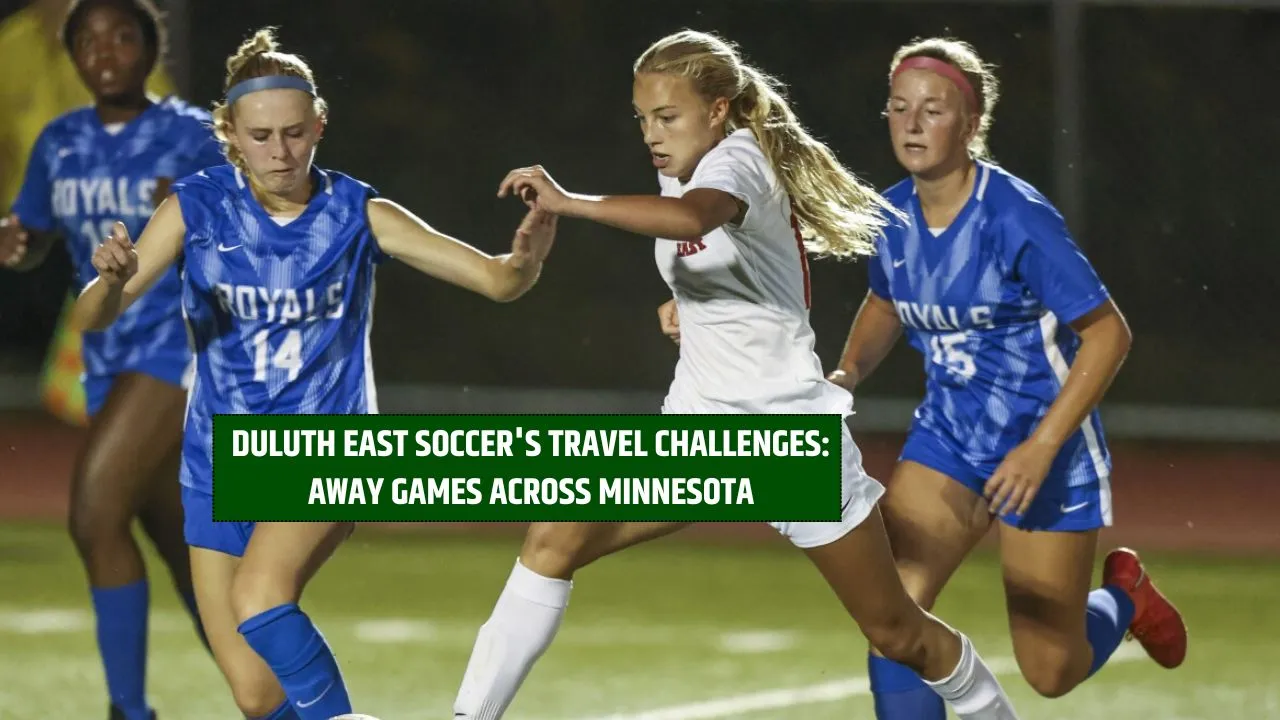Duluth East Soccer doesn’t just play the game — they live the miles. Based in the far northern corner of Minnesota, the team’s regular season feels more like a statewide tour. While other high school soccer programs in urban and suburban areas enjoy short trips for away games, Duluth East must routinely prepare for multi-hour bus rides, unpredictable weather, and tightly packed schedules. Every game outside their region is a true journey.
This article explores the Duluth East Soccer team’s unique experience traveling across Minnesota. From physical strain to academic stress, and from budget concerns to weather disruptions, we’ll look at how these travel demands impact players, coaches, and the community. You’ll also find practical insights into how the team is adapting, supported, and striving to compete on equal footing despite the long road ahead.
Duluth East Soccer: Distance, Dedication, and Determination
Travel is not a side issue for Duluth East Soccer—it’s a defining part of their season. Located far from most Class AA schools in the southern half of the state, Duluth East often travels over 100 miles per game, with some trips pushing 250 miles round-trip. These away matches are not quick detours—they are full-day commitments. Yet, the team continues to show up, perform, and maintain their competitive edge. This section outlines how this exceptional travel burden tests the limits of endurance, discipline, and support for one of Minnesota’s most determined high school soccer teams.
Overview of Travel Burden
| Category | Details |
| Average Travel Distance | 100-250 miles round trip per game |
| Total Travel Time per Season | 40+ hours on the road |
| Key Opponents’ Locations | Twin Cities Metro, Central Minnesota |
| Number of Away Games | 8 to 12 per season |
| Common Travel Days | Weekdays after school |
| Primary Travel Methods | Charter bus or school district bus |
| Estimated Travel Costs | $5,000–$8,000 per season (transportation, meals, etc.) |
| Top Weather Risks | Rain, fog, early snow, icy roads |
Why Travel Is a Big Deal for Duluth East Soccer
The location of Duluth means that competing at the highest levels of Minnesota high school soccer requires constant long-distance travel. The team often leaves school early in the afternoon, arriving at distant fields with barely enough time to warm up. After games, they return late at night, sometimes after midnight, only to be back in class the next morning. For most high school programs, a long trip is an exception. For Duluth East, it’s the rule.
Because of these frequent trips, Duluth East Soccer players and coaches must prepare differently. Packing food, staying hydrated, wearing compression gear during the ride, and even stretching on the bus have become part of their standard preparation. These aren’t luxury accommodations—they’re survival strategies for staying sharp and reducing fatigue during demanding weeks.
Effects on Players’ Health and Academics
Time spent traveling directly impacts both the physical health and academic performance of student-athletes. Sitting on a bus for hours before stepping onto the field can leave legs stiff and minds distracted. Recovery time is shortened, and consistent sleep schedules are disrupted. The strain becomes particularly tough during back-to-back game weeks or when early season weather reschedules games with little notice.
Academically, missing afternoon classes several times a week is a genuine concern. Teachers at Duluth East have been understanding, but the burden falls on students to keep up. Many players study on the bus, complete assignments in advance, or use digital tools to stay in touch with lessons. Yet the juggling act is far from easy, and burnout is a real risk by mid-season.
Coaches Face Time and Strategy Challenges
High school athletics in rural areas require more than just playbooks and drills—they require logistics mastery. Coaches at Duluth East have to manage player conditioning, plan game-day meals, and keep their teams focused through lengthy road trips. Game preparation must start the moment the players get on the bus, and recovery protocols begin before the final whistle.
In practice, this means fewer training hours between games, less time to review film, and limited opportunities for in-depth tactical work. Coaches often adjust lineups based on who’s handling the travel best or who’s had enough rest. It’s not just about strategy—it’s about managing energy wisely across the week.
Long Travel = Extra Costs
Each trip comes with a price tag. Duluth East Soccer faces higher travel expenses than most of their competitors. Costs include charter buses or fuel for district buses, driver pay, meals on the road, and sometimes hotel stays if back-to-back games are scheduled far from home.
With school athletic budgets already stretched, additional fundraising becomes essential. Booster clubs, parent volunteers, and local businesses often chip in, helping the team cover expenses without cutting corners. Still, financial pressure is always present, especially when playoffs add more games and more miles.
Weather Can Be a Game Changer
Northern Minnesota weather plays a major role in the team’s travel difficulties. In early fall, Duluth can experience fog, heavy rain, and even early snow, all of which can impact travel safety. Some away games are canceled or delayed due to dangerous road conditions. For student-athlete challenges, this means constantly changing schedules, unexpected overnight stays, or long detours that add more stress to already long days.
For teams like Duluth East, travel isn’t just about distance—it’s about adapting quickly to environmental surprises that schools in milder climates may not even consider.
Key Travel Struggles Faced by Duluth East Soccer
- Distance from Metro Area Teams: Most high-ranking programs in the state are located in or near the Twin Cities. Duluth East must travel further for quality competition.
- Limited Local Opponents: The region lacks other schools with the same soccer competitiveness, forcing the team to look southward for serious matchups.
Support from Families and Community
Behind the scenes, parents, fans, and community members help make the long travel possible. From organizing meals and snacks to coordinating fundraisers, their involvement is crucial. Coaches often credit the community as the “unsung MVPs” of Duluth East Soccer. Without them, the team wouldn’t be able to maintain such a grueling travel schedule.
The commitment extends beyond logistics—supporters show up at away games, sometimes driving hours to cheer the team on. That level of loyalty brings a sense of pride and motivation that fuels the team throughout the season.
How Technology Helps Manage Travel
Digital tools are becoming an essential part of managing sports travel. Coaches use apps for scheduling, GPS to track routes and timing, and communication platforms to update parents and players. Students access class notes and complete homework from the road using school-issued devices.
This mix of physical travel and digital learning reflects how rural school sports are evolving. Without these resources, the burden of travel could be even more overwhelming for players balancing academics and athletics.
Solutions That Could Make a Difference
- Scheduling smarter: Pairing games against multiple teams in a single region over a weekend could reduce total travel days.
- More local tournaments: Hosting multi-team events in Duluth can help reduce travel needs and bring competition to the team.
- Flexible academic support: School districts can consider offering structured online learning days for travel-heavy weeks to help players keep up academically.
FAQs
Why does Duluth East Soccer travel more than other teams?
Because of its remote location, most strong soccer teams are several hours away, making long-distance games unavoidable.
How does travel impact players’ school performance?
Frequent absences from afternoon classes and late-night returns make it harder for players to maintain academic focus without strong support systems.
What are the biggest financial burdens of the season?
Travel-related costs like bus rentals, meals, and fuel significantly increase the team’s expenses compared to metro-area programs.
Does weather affect game schedules?
Yes. Rain, fog, and early snow in northern Minnesota often force changes in travel and game schedules.
How does the team stay competitive despite travel issues?
Through careful planning, community support, and mental toughness, the team continues to maintain strong performances year after year.
Final Thought
Duluth East Soccer is more than a team—they’re a traveling force that embodies resilience, teamwork, and dedication. Their season is measured not just in goals scored, but in miles traveled, hours studied, and community support earned. Despite the travel challenges, this team continues to compete, inspire, and lead with grit and heart. If you’re inspired by student-athletes who go above and beyond, consider following their journey this season. Share your thoughts in the comments or explore other stories about the athletes shaping Minnesota’s sports landscape.











